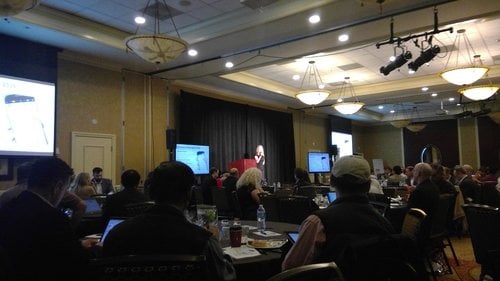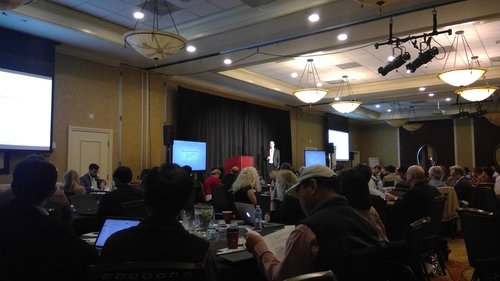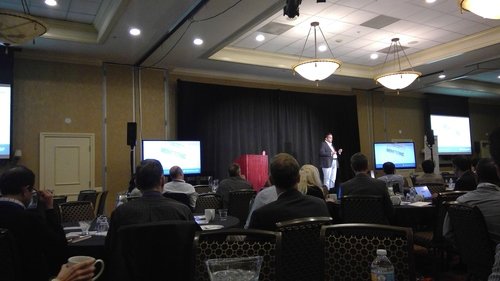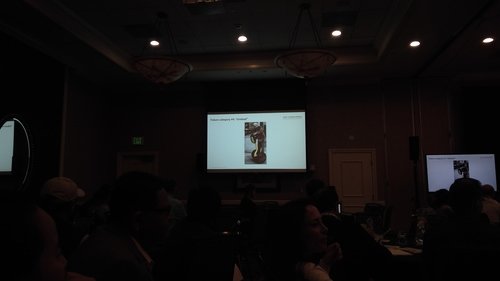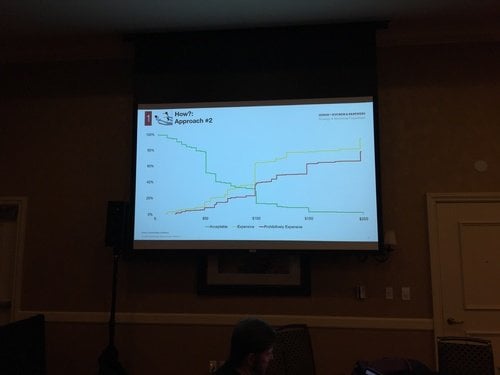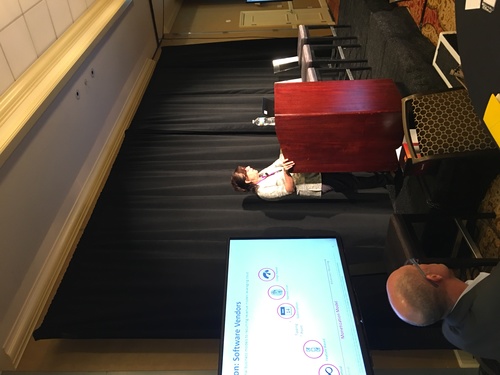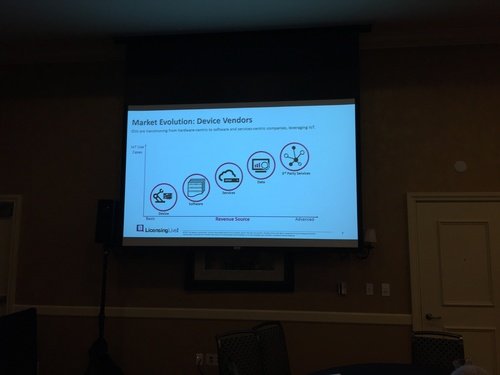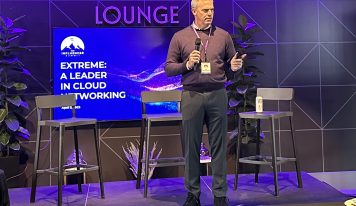11/2/16 9:38 AM PST We are about to start.
For more info on the topic check out
What is Software Monetization?
Ariella Shoham Sr Director Marketing SM, Gemalto Software Monetization Unit.
This event has been going on for seven years.
10:25
Shlomo Weiss Senior Vice President, Software Monetization, Gemalto takes the stage. Session topic”
Embracing Change: The Shift from Making Products to Selling Value
When he was younger he started collecting baseball cards and eventually it became a business. At one point they tried a different angle – they blindfolded a kid and let him pick from a group of cards for 50 cents. They then realized if there were higher value cards, they could charge more. Eventually the principal shut them down but they learned about value and charging.
This concept applies to software today.
- What is core value in your offering? How has it evolved?
- How do you capture that value?
Value is dynamic – it changes based on factors like market demand and trends – baseball cards for example have a different value today than in the past.
Discussion shifted to Now Economy.
Examples are Amazon, Netflix, Uber, SolarCity, etc. Bringing value closer to consumer.
Uber for example has set an expectation of immediacy and pricing is dynamic – they can test new things. They can also scale rapidly because of the automation in their business.
These companies are all data driven – its the new oil or new currency. It requires near instant provisioning. Also – they live in a connected ecosystem.
The Now Economy is not just for consumers – its reshaping industries – transforming how business is being done.
“The new economy for business and how it gets monetized.”
Examples:
4th Manufacturing Revolution: He suggested we listen to the following: Olivier Scalabre: The next manufacturing revolution is here. He summarized the talk about how automation is changing manufacturing – eventually products will be made in a custom fashion at the same cost as mass production.
He described how UPS has 3-D printers and is testing bringing goods closer to customers or the point of demand.
Connected healthcare – over $400B will be spent on IoT. Forbes had an articled called the Uberification of Healthcare. There will be better healthcare where people didn’t have access int he past.
Smart farming: Economist had an article on Almonds – 80% of them are produced in California. Each requires a gallon of water. Detailed a farmer who used tech to determine how to save money by allowing irrigation to connect with sensor inputs. A dramatic drop in water usage was the result. Many of the new economy examples were brought into this solution.
Software is everywhere – is the enabler. We have to think how do we monetize it. Over the next days we will hear about customer experience. Businesses will expect same features.
Business models need to be flexible – they keep changing. You need to have strategy and infrastructure in place.
Need to have operational automation and data driven intelligence. Finally, need security and protection to ensure you keep customer trust.
These will be the themes of the event this week.
Final quote from Jeff Bezos:
“You should wake up every morning drenched in sweat not because you are afraid of competitors but customers because they are the ones who have the money.”
11:00 AM
Amy Konary Research Vice President, Software Licensing and Mobile Enterprise Applications, IDC
Mark Seery Sr. Director, Strategy and Corporate Development, Juniper Networks
Topic: Delivering Software Driven Value
This was more of an interview style talk. I’ll share important thoughts as they happen.
Productivity is a bigger driver of cloud adoption than cost savings.
In the next 24 months we will see a big shift to outsourced private or public cloud.
IDC data shows the Now Economy has changed customer expectations of timeliness. “The democratization of technology” is changing business models due to the need for better customer experience.
Juniper has many types of partners. Some are high volume and low margin – others add lots of value. They have to understand how the partners make profit. Any changes they make have to take into consideration how it could affect partners.
11:45 am
Jeff Kaplan Managing Director, THINKstrategies:
Innovative Software Demands Innovating Licensing – Connected Cloud and Beyond
How IoT ties into software monetization. Asked about book – Discipline of Market Leaders
Premise: You could be a product leader/differentiation, operational excellence or customer intimacy.
Book was from 1994 and a lot has changed since then – there is a new set of engagement models – from cloud to different techniques.
Another book from Thomas Friedman The World is Flat was mentioned.
Cloud and nanotechnology = new IoT opportunities – the question is how to monetize these things.
Much of the industrial world is becoming automated – thanks ot digital transformation. It’s changing almost every industry such as entertainment and media.
Existing companies need new tools and techniques to determine who is the customer and how to satisfy their needs.
Marketing is becoming data driven and analytics oriented – much more scientific.
89% of marketers plan to compete on customer experience according to Gartner by 2016.
Discussed four Ps of marketing: Price, product, promotion and place/packaging.
Gartner adds Personalization, Proactivity, Proven capabilities and Peer influence (community).
Much of this is being driven by software.
The old world says you can be successful in one area – the new world requires you to do all things well or you cant compete in this marketplace.
Used Salesforce as an example… Amazon’s Dash button.
We are moving from standalone products – we are in the data business and need to understand how we monetize this data.
Used example of Philips Lighting – can help companies economize on use of lights as the light bulb industry is highly commoditized. John Deere Information Services Information Services has added lots of vale for customers.
How do you package and price this software?
12:00 pm
Laila Arad-Allan Director of Product Management, Software Monetization, Gemalto
Innovative Software Demands Innovating Licensing – Connected Cloud and Beyond
Connected licensing allows attractive business models such as subscription, pay per use etc. Can be done on the fly. Expands your market and allows customers to consume software according to preferences. Can have lower entry-level pricing for customers.
Cloud now allows usage based licensing – attractive to vendors and end customers. Subscription plans need to be flexible to be useful. Usage-based licensing needs to be able to scale up and down.
Business Intelligence gives insight on customer feedback – can see which features are used – how they are used. You can determine product roadmaps and differentiation
as well as upselling opportunities.
Marketing profiles allow you to determine that customers using one module often like or need other modules. Can reach out to sell these customers other modules. Can use this knowledge to reduce churn.
Entitlement Management how do customers know what they’re entitled to? This is where entitlement management comes into play. Its the backend of software monetization. This reduces IT and operational costs. Allows you to make product packaging and activations as well as data reports to understand product usage. Many companies are still doing this manually. If done right – it should also allow customer self- service.
Need to have best practices – not just the best product. You need to embrace cloud to boost customer experience and finally – consider using a partner when making the jump to software monetization.
Lunch
1:30 PM
Joshua Bloom Partner, Simon-Kucher & Partners
Bill Graber Director of Marketing, Trimble Navigation Limited
Darim Rahmatallah Product Manager, Software License Enforcement Solutions, Gemalto (moderator)
Andres Botero Senior Vice President of Marketing, Aria Systems
Crossing the Licensing Chasm – How to Transition to a Recurring Revenue Model Today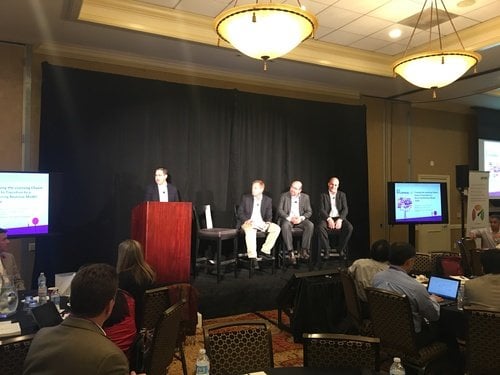
Joshua: 83% of companies are feeling pricing pressure – more than 50% of companies think they are in a price war.
How can you acquire, monetize and retain all at once?
Can have a one-size fits all price but you’ll have low volume. Can have a free offer but you’ll have lots of churn. The goal is to bring in customers and upsell over time.
There is no magic bullet. You need to have a packaging line-up that speaks to different customers through their journey.
In packaging there is a spectrum of flexibility… You should have functional packages as well. Tracking metrics allows you to have better contracts – can have fixed and variable. As well as some up front fees with scaling portion.
There is no one size fits all – especially if customers range from small to large companies.
Also – you can have various cloud models – on premise, hosted, public cloud, hybrid etc.
Companies that have products where the main value is based on use can have a low entry point but ability to grow faster than inflation. You take a lot of indicators – can see if a customer has been wildy successful and can subsequently push a higher rate.
Bill: Trimble is a hardware company moving to software – more than half of revenue is now software. We are moving to RMS. We turn dongles into a religion – we have over 20 for all of our software. Its exciting to move away from them.
Much of our software is perpetual. We align ongoing revenue with ongoing expenses.
Why SaaS is important to Trimble: Have to add software to hardware like you do with a cellphone. We are making it easier for our customers to move from device to device.
How to determine when SaaS is a good approach? Does it need to work offline? is it multiuser?
They are looking at subscriber models with various levels of GPS accuracy. Possibly allowing allowing custoemrs to change the level as needed.
They are also working on Aerial Photogrammetry – tell a drone where you are and where you want it to go… It can capture a point every three centimeters. In 35 minutes it can cover 4 square miles and take 10 Gb of data. You get a point cloud – basically like a very detailed Google Maps or BirdsEye view on steroids from Bing.
Allows a virtual replica of a building – great for architectural wonders.
It’s $40k for the drone and software.
To do this manually could take years.
They will keep the software with the drone. It takes a few days to take the data and turn it into a map.
They can host the data and do cloud-based processing… They could have a subscription for the data and use the software based on usage.
Dynamic Compaction at Beijing National Airport. Its like 60 KM of a 4-lane highway.
They have a very heavy wight which they keep dropping until there is less than 15 cm on two drops. Their DPS900 software does this for the Chinese. There is a camera and cloud monitoring system which can live in the cloud.
Future goal: Eliminating the perils of survey and construction.
In response to audience question – he said the sales team realizes it needs other licenses besides perpetual to ensure they are competitive with other companies.
In other words a $20k perpetual license doesn’t make sense for a company that needs a year of use – in this case they can perhaps be charged $5k.
Andres: We enable companies to dream of any monetization model and realize it. It is also customizable and flexible. If you try to do this with your current IT – it is very tough. Our solution allows you to do this without starting from scratch each time.
We enable companies to create more revenue and keep more companies happy.
2:24 pm
Dave DiMillo Principal Consultant for the Software Monetization division at Gemalto
Vickie White Director of Virtual Products, Gemalto
Customer Driven Operational Efficiency
A discussing on internal Gemalto business – acquisitions which have created silos she calls dirty laundry. They have been transitioning from hardware to virtual. In the operations and supply chain areas, they are having issues determining how to deliver virtual solutions in the ERP system for example.
Discussion of usage based billing, low friction product trials, expanded self-serve (transfer licences between devices, etc.) and online ordering.
3:00 pm Snack Break
3:30
Avni Rambhia Industry Principal, Digital Transformation, Frost & Sullivan (moderator)
Rishi Katdare Sr. Program Manager, Licensing Services Group, NetApp
Mark Russell Head of Strategy and Business Development, Business Unit Media, Ericsson
Don’t Leave Money on the Table: Entitlement Management
Mark: Traditionally we packaged and boxed products and sipped them to customers. We saw five years ago the world was going to be at a tipping point… Software was going to offer more value than hardware. “We are a point now where half our media products are in this mode” where
we sell services. We “literally had to reorganize the whole company.”
Talk of DevOps – licensing and entitlement ops. Cloud and mechanics of cloud and microservices were complete mysteries 4-5 years ago but now, most of our customers understand it all.
You need to have an alignment of an as a service approach with a customer need.
Rishi: We are a startup within NetApp. We released there needs to be a focus on licensing entitlement. We are selling data on tap solutions. How we help different customers is working with operation and getting transition licenses. Ops comes in and creates mobile ops licenses – can determine entitlement set.
Avni: Make sure you have a have a cash reserve when you make the transition because it takes time for money to come in with a subscription model. I’ve covered this before – David Walsh, CEO of GENBAND calls it the fish problem. My colleague Paula Bernier explains it very well.
Rishi mentioned in Japan they don’t go cloud because of their culture. Avni chimed in with DoD as being the same and the audience shouted (respectfully) out healthcare, as well.
Mark: We (Ericsson Media) are just over 20% in subscription revenue now and we expect the lines to cross in the next 2-2.5 years. In 5-6 years I expect this to be true for all of Ericsson.
4:20 pm
NFL Star Terrell Owens
He is very socially savvy. He is an entrepreneur. He’s always been about fan engagement. Technology is where the world is going, what I’m involved with Mixonium – a user friendly dashboard – allows easy access. There are so many benefits to it. Advertising, etc. The sky’s the limit.
Day 2 Begins
Ariella Shoham Sr Director Marketing SM, Gemalto
She went over the past day and introduced the next round of speakers. A special bonus book signing is coming at the break. The author is Madhavan Ramanujam Board Member & Partner – Simon-Kucher & Partners. She talked about a session titled Monetizing the IoT which is coming up after the break.
Madhavan Ramanujam Board Member & Partner – Simon-Kucher & Partners
Monetizing Innovation: How Smart Companies Design the Product around the Price
His journey started at Stanford – he had a team and pitched an idea to a VC. He was asked, how do you know you will monetize your idea. The VC said, you labeled it correctly, these are your assumptions, how do you truly know you can monetize your idea. This is what spurred him to join Simon-Kucher & Partners and he says we will now learn how we can truly know if we can monetize an idea.
He segued into a car story – Porsche – they were having financial problems. They needed a new idea. They came up with an SUV idea. They found via research that people would buy their sports utility vehicle. They tested every feature to see if they needed it, valued it and would pay for it. The 6-speed manual transmission didn’t make it but a big cup holder was in.
Fiat-Chrysler wanted to own the compact sedan market – they wanted to resurrect the Dodge Dart. He played a commercial.
This car was designed by the engineers – the commercial sort of explains it. As a result, Porsche had wild success with the the Cayenne but the Dart did not appeal to customers. MarketWatch called it the second biggest innovation flop of the year- Apples Maps was first.
Fiat-Chrysler stopped producing the car last month.
His company surveyed more than 1,000 countries – 80% of companies said they are in price compression – 60% said they are a price war – the vast majority blamed their competition for this.
Innovation is the number one way companies are looking to overcome this problem. 72% of innovation failed completely or didn’t meet revenue and profit targets.
They found products fail for four reasons/ways.
Feature shock: Overengineered and nothing stands out. The product resonates with no one. “One size fits all.” Instead of putting out different versions for different markets. Amazon Fire phone is an example of this situation. It had four cameras to track your eyes so you didn’t need to wear 3-D glasses. The entire Fire Phone experiment failed.
Minivation: The right product that the entrepreneur was afraid to charge the right price. A semiconductor company came up with a game-changing product. The previous version cost 65 cents. They charged 80 cents. They should have charged more for this game-changing product. Afterwards they saw their customers were charging $50 more for this innovation… They could have charged a lot more.
Hidden Gems: Products which make you uncomfortable. They happen when a company does something new – hardware company doing software or vice-versa. A hardware company innovates in software – but don’t charge for it because they didn’t understand the value. Kodak had digital photo technology in 1971 and they didn’t bring it out because they were afraid of cannibalization.
Undead: Products shouldn’t have built and come back to haunt you. Wrong answer to right question or answer to question no one cares about. Cool graphic – zombie on a Segway to show his point.
Criteria for success:
Price before product: Price is a measure of value. Successful companies understand if people will pay for their innovation before they overly invest. They bring pricing in R&D stages of innovation. Others stick on a price afterwards.
Have to have talks with customers to see what they would pay.
C-Level Involvement: 35% better chance of success with senior management involvement.
Nine step framework to cross the chasm
1) Have the WTP (willingness to pay) talk early. Ask not just about the product but whether market would pay what you want them to pay. Would you like a $20 cup of coffee for example. With this in mind you can decide which features to focus on. Gave example of a company building a product – the CEO asked how do you know people would pay or this? They did research and counter-intuitively saw that easy features had more value to customers. For example a feature that showed a friend purchased something from the same seller – they tought this was great but audience didn’t want to share their product purchase history with others. Instead they focused on ten things that matter and launched.
Approaches:
A) Just do it: Describe product – ask how much people think the value would be relative to other products they purchase – such as Salesforce if you have a cloud solution. At the beginning, customers won’t be in negotiation mindset so you’ll get a good price – or range.
B) ask people what price is acceptable, expensive or prohibitively expensive (laughed out of the room).
C) Ask consumers what they would pay for your solution but with different features. Do it in a way which allows you to back out the value of the individual features to the user.
2) Segmentation: Example: Water – value changes based on things like packaging – water in a fountain and bottle have vastly different value. Showed example of segmenting people in the UK – who have a lot of money and live in a castle. You get Prince Charles and Ozzy Osbourne – and they have vastly different needs/desires. Segment the market based on how you need to act differently.
3) Innovate and market differently based on segment.
There are four segments:
- Want the best
- Want it now
- Want product only
- Want price only
4) How you charge is more important than how much you charge. Tires are truly a commodity. Michelin increased price by 20% because tires lasted 20% more – they showed price per kilometer. Truckers loved this – they could pass along this cost now.
How to do it? People don’t do the math – they have models which create less friction. People always have a preference – fixed versus percentage.
We skipped 5-7
8) Your customers will behave irrationally – there are psychological thresholds – $79 is the same as $99 for example. They were able to get a customer to increase ARPU by 36% by analyzing and repricing and changing features in various bundles.
Need teams to be involved in pricing decisions – sales, marketing, C-level, etc. You need to change to take advantage of these ideas.
I asked about Apple (we are in Cupertino after all) – they don’t launch in this manner… How can they do what they do? The answer is that there are a few companies like this which are able to have massive success – most fail. There is a chapter in the book which discussed this idea in-depth.
11:48 am
Chris Kocher Founder and Managing Director, Grey Heron
Todd Steel Director, Product Management in the Software Monetization division at Gemalto
Kevin Coyne VP Product Marketing, West Corporation, Safety Services –
Monetize the IoT: Show me the Money
Key areas driving the IoT ecosystem
- Smart cars
- Intelligent transportation
- Buildings
- homes
- Health
- Cities
- Retail
- Industrial
- Utilities
- I missed the last one
Ecosystem partnerships are critical for monetization
Link monetization to customer value and usage
Kevin: Tied in the “Now Economy” with the services they provide – specifically E-911, smart firefighting. Discussed the National Public Safety Broadband Network NPSPN (FirstNet) – a dedicated network for emergency responders. Went over Smart Public Safety Ecosystem – brings in weather, DOT, GIS, SMS, MMS, social, RSS, telematics, etc.
Talked about how they use Gemalto sensors to to monitor buildings and weather, etc. Showed demos of mapping in action – what first responders can see when there is an emergency. Who is in the building? What are the critical areas.
Todd: Do some analytics to decide the pricing options.
Chris: Allows you to align pricing with value perceived. Entirely new ways to build business models and generate revenue.
Todd: Metering opens you up to new markets. MRI machines for example – $5M machines. In big cities it makes sense to buy as you can pay for it. If you charge per scan – lease device – you can make sure you reach lower-level market. Just opening a new market with a new business model. Likewise in CAD industry – you can introduce yourself to new markets with this pricing.
Kevin: Answered security question form audience saying they are already trusted to deal with 911 information. They are secure.
As an aside, my company (TMC) has be covering West since the early 1980s when they became a giant in the call center space. They purchased Intrado some years back to get into the 911 space.
1:30
Laila Arad-Allan Director of Product Management, Software Monetization, Gemalto
Sentinel Software Monetization Strategy
40% of software vendors selling perpetual software licenses only – our (Gemalto’s) focus is is on the top right 3 below.
Device vendors are spending 70% of their R&D on software in the device but they gain no revenue. She referred to the hidden gems idea above – you can gain revenue from them.
Vendors have to keep multiple variants of products to address various market needs. When features are hardcoded they need to change embedded software to add or change features.
We are currently in the bottom three below – this is where Gemalto is focusing.
Sentinel EMS 2016 – single EMS for multiple licensing systems – supports RMS, cloud licensing, third party solutions, homegrown, etc. In one platform.
Eventually will have ESD as a service – one interface from downloads to releases and entitlements. Will send emails to customers based on entitlements. Will eliminate complexity of having separate EMS portals.
Will also allow group level access control.
3:05
Todd Steel Director, Product Management in the Software Monetization division at Gemalto
Creating Value in the IoT – Introducing the newest member to the Sentinel family of products
Transformation of revenue source from selling hardware to software subscription. Nest Thermostats – they were able to take usage of gas and electricity in different geographical areas and sell it to energy companies. These are the types of things company can sell – try to figure out what to sell and how to sell. Perhaps you can allow after market applications on my device?
Other ideas – tennis racket company – builds community – sells the data – creates ecosystem – allow you to become a bigger, healthier company with new revenue streams and new customers.
Want to have product control to ensure there is no black-market production of your devices.
Conclusion
The bottom line is this event focuses on the software monetization market which offers tremendous opportunity for many companies. The general trend towards hardware commoditization means software is gaining importance. Moreover, consumers and businesses are getting used to paying for software on a subscription basis. In addition, customers are looking for increased flexibility in how they purchase solutions and companies able to meet the challenge are best-positioned to win this business. Finally, many companies – have tremendous value locked up in their intellectual property… If they are able to unleash it, they can increase value to customers as well as sales and profits.


